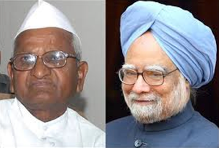 Over the last few weeks the most dominant news story has been the attempt by civil activist Anna Hazare and his team to pressure the government into implementing their version of the anti-corruption Lok Pal bill.
Over the last few weeks the most dominant news story has been the attempt by civil activist Anna Hazare and his team to pressure the government into implementing their version of the anti-corruption Lok Pal bill.
It is beginning to look like, at the time of writing, that after weeks of playing hard ball with each other both parties may be tentatively moving towards a compromise that will benefit the country. However they have broken just about every best practice negotiating principle as laid out by the Harvard Negotiation Project.
Principle 1: Separate the people from the problem – The debate had become a volley of personal accusations and counter accusations rather than an exploration of potential solutions. With Anna belligerently accusing the UPA of ‘murdering democracy’ and the spokesperson of the UPA asserting that Anna’s supporters consisted of ‘armchair fascists, overground Maoists, closet anarchists … and funded by invisible donors whose links may go back a long way abroad’ there was little being generated in the way of openness or conciliation to each other’s potentially valid points.
Principle 2: Focus on interests rather than positions – it appeared that both sides got stuck into positionality. Anna refused to stop his fast unless his version of the Lok Pal bill was passed by Aug 30th. The government refused to withdraw its own initial draft of the bill even though the Lok Pal it envisaged was almost universally considered to be toothless. The underlying issues that both parties should actually have been more concerned about were – making sure that the Lok Pal is an effective mechanism for reducing corruption and that there are adequate checks and balances on its power over the democratically elected representatives and the, until now, relatively independent judiciary of the country.
Principle 3: Invent options for mutual gains – Both parties seemed to see only two options. The UPA appeared to see it as a choice between implementing their bill or giving in to Anna’s demands. Meanwhile Anna appeared to see it as a choice between giving up his fast (i.e. losing) or going on till the UPA caved in or perhaps till he had extracted enough concessions to end the fast with honour intact (in six previous fasts he has only once fasted longer than 9 days even when his demands were only partially met). It’s only when a number of different options are considered that the ones that are acceptable to both parties will start emerging.
Of course the above principles would only have been followed by those people genuinely looking for a resolution and it is not at all clear that that is the situation here. Ego and image may well have taken priority over the real issues as they often can do in personality based politics. Thankfully it looks like we are moving slowly to a slightly higher quality of debate as both sides look for face saving ways of softening their stance.
In the meantime we can learn from the situation by asking ourselves whether we are (or were recently) stuck in a negotiation at work or in our personal lives where the positions seem irreconcilable.
How can you use principled negotiation to reach a win win solution?
Note: In the book ‘Getting to Yes’ by Fisher and Ury there is a fourth principle – ‘Use objective criteria’